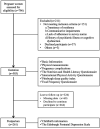Correlation of lifestyle behaviors during pregnancy with postpartum depression status of puerpera in the rural areas of South China
- PMID: 38192564
- PMCID: PMC10773618
- DOI: 10.3389/fpubh.2023.1304226
Correlation of lifestyle behaviors during pregnancy with postpartum depression status of puerpera in the rural areas of South China
Abstract
Background: Postpartum depression (PPD) is among the most common postpartum complications. Its prevalence is associated with strong regional variability. Women in rural areas of China have a high risk of PPD. The aim of this study was to investigate the PPD status of women in rural South China and explore the effects of modifiable lifestyle behaviors during pregnancy on their PPD status, thereby providing a scientific basis for the prevention and intervention of PPD in rural China.
Methods: A cohort study was conducted on 261 women from four maternal health institutions situated in rural areas of Guangdong Province and the Guangxi Zhuang Autonomous Region from October 2021 to December 2022. The questionnaires were administered to these women to obtain data about sociodemographic characteristics, health literacy, physical activity during pregnancy, and sleep and dietary status during pregnancy, as well as depression status on the 42nd day after delivery. The lifestyle behaviors during pregnancy and the PPD status of the study population were analyzed. Multiple linear regression models were used to determine the correlation between lifestyle behaviors and PPD status. Path analysis was performed to explore the interaction between various lifestyle behaviors.
Results: A total of 14.6% of women had a PPD status. Women who continued to work during pregnancy had an Edinburgh Postpartum Depression Scale (EPDS) score of 1.386 points higher than that of women who did not (В = 1.386, β = 0.141, p = 0.029). For every 1-point increase in the infant feeding-related knowledge score and pregnancy diet diversity score, the EPDS score decreased by 0.188 and 0.484 points, respectively, and for every 1-point increase in the Pittsburgh sleep quality index score, the EPDS score increased by 0.288 points. Age was related to infant feeding-related knowledge (indirect path coefficient = 0.023). During pregnancy, sedentary time was correlated with sleep quality (indirect path coefficient = 0.031) and employment status (indirect path coefficient = 0.043).
Conclusion: Employment status, infant feeding-related knowledge, sleep quality, and diet diversity during pregnancy directly influenced the PPD status, while age and sedentary time during pregnancy indirectly influenced the PPD status. Promoting healthy lifestyle behaviors, including reducing sedentary time, improving sleep quality, and increasing dietary diversity, may be effective in reducing PPD occurrence.
Keywords: correlation of data; depression; life style; postpartum; pregnancy.
Copyright © 2023 Ding, Li, Shi, Wang, Peng, Deng, Yang, Liang and Wang.
Conflict of interest statement
The authors declare that the research was conducted in the absence of any commercial or financial relationships that could be construed as a potential conflict of interest.
Figures


Similar articles
-
Prevalence and Risk Factors of Postpartum Depression Among Women in Low-Income Developing Rural Areas: A Cross-Sectional Study in China.Depress Anxiety. 2024 Oct 1;2024:8841423. doi: 10.1155/2024/8841423. eCollection 2024. Depress Anxiety. 2024. PMID: 40226729 Free PMC article.
-
Risk factors for the development of postpartum depression in individuals who screened positive for antenatal depression.BMC Psychiatry. 2023 Aug 1;23(1):557. doi: 10.1186/s12888-023-05030-1. BMC Psychiatry. 2023. PMID: 37528383 Free PMC article.
-
[Association between postpartum depression and concentrations of transforming growth factor-β in human colostrum: a nested cohort study].Nan Fang Yi Ke Da Xue Xue Bao. 2022 Sep 20;42(9):1426-1430. doi: 10.12122/j.issn.1673-4254.2022.09.21. Nan Fang Yi Ke Da Xue Xue Bao. 2022. PMID: 36210718 Free PMC article. Chinese.
-
The role of sleep protection in preventing and treating postpartum depression.Semin Perinatol. 2024 Oct;48(6):151947. doi: 10.1016/j.semperi.2024.151947. Epub 2024 Jul 14. Semin Perinatol. 2024. PMID: 39048415 Review.
-
Postpartum Depression: Etiology, Treatment, and Consequences for Maternal Care.Diagnostics (Basel). 2024 Apr 23;14(9):865. doi: 10.3390/diagnostics14090865. Diagnostics (Basel). 2024. PMID: 38732283 Free PMC article. Review.
Cited by
-
Association between oxidative balance score and risk of postpartum depression in Iranian women: a prospective cohort study.Sci Rep. 2025 Mar 12;15(1):8590. doi: 10.1038/s41598-025-93206-y. Sci Rep. 2025. PMID: 40075109 Free PMC article.
-
Prevalence and Risk Factors of Postpartum Depression Among Women in Low-Income Developing Rural Areas: A Cross-Sectional Study in China.Depress Anxiety. 2024 Oct 1;2024:8841423. doi: 10.1155/2024/8841423. eCollection 2024. Depress Anxiety. 2024. PMID: 40226729 Free PMC article.
-
Physical activity and sleep quality among pregnant women during the first and second trimesters are associated with mental health and adverse pregnancy outcomes.BMC Womens Health. 2024 Aug 13;24(1):455. doi: 10.1186/s12905-024-03126-8. BMC Womens Health. 2024. PMID: 39138442 Free PMC article.

